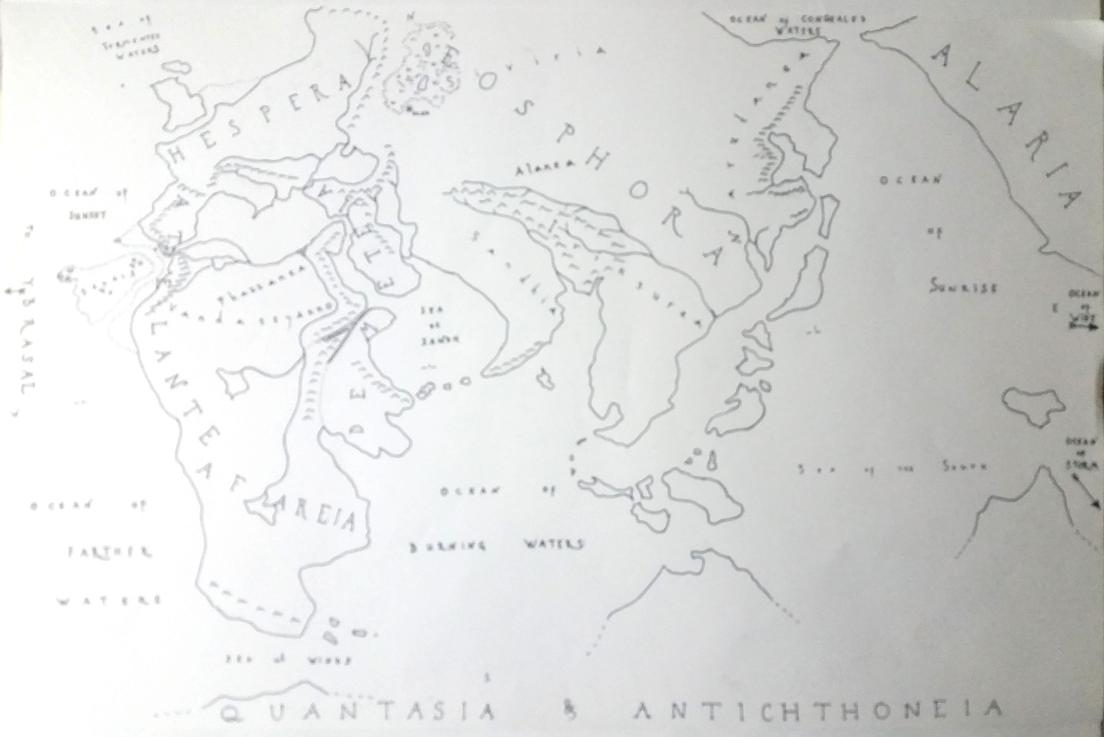The World Atlas
Any planet of respectable age has undergone considerable changes and evolution of its surface geology. Some planets go in for rabid vulcanism, others seem to prefer the sedate dance of plate tectonics while still others prefer to let the rain of asteroids and meteors do all their cosmetic work for them. Gea has certainly suffered bouts of meteors in her past, but for the most part the surface changes are all due to a kind of subtle shuffling dance of those mighty Beings that inhabit the deep mantle of the planet, and it's these folks who hoist up the continental plates upon their broad shoulders and make sure all the lands of the world get to move around a bit.
A Diagramme of the Interior of Gea
At the center you can see what is called the Heart of Gea, a realm of intense heats and the solid core of the planet; the home of Yeola Stardaughter. Beyond that inner core lies the outer core and its raging hurricanes of thaumic, magnetic and electric winds, howling up from the inner core; the home of some very bizarre creatures indeed! Next is the more solid, but still rather gooey layer of the mantle; it is here the great Beings live who hold up the solid surface of Gea; they bear upon their mighty shoulders the Arcades of the Deep; lastly is Midworld itself, the landrealms and oceans of the surface world. Beyond the planet itself are the airs above, home of bird and stormcloud alike. And beyond all beyonds lies the rarified airs of Aethir, where Sawel, the Sun herself, rests in majesty at the center of All That Is, and round her whirl the thirteen planets, and their moons, and beyond all, the realm of the fixed stars. Gea has two moons: Selanna is the greater of them and is nearly her own twin; Wesara is surely a cold ball of bright ice whirling round our world. The Hotai believe that Gea has a third moon, invisible to all but themselves; and they are fools for thinking such rubbish! Near the image of Selanna is the asterism Martellus, the Hammer; near Wesara is the asterism Bastun, the Staff; and across from Sawel is Arcuz, the Bow. Several smudgy stars are visible in our skies, but most are clear points of light emanating from the distant heavens. With the aid of the telespeculon, astrologers have discovered six planets beyond the seven known anciently: farthest away is Posedonias, then Warsuwanas, then Nenurta and Mardouc, who is the king of the planets and largest of all; then come Demeter, Hestias, Pallades and Panacea, all very small planets indeed; then the broken world that is Ceres; then Ares, Gea herself, then Estarea, then Apollo and finally Setilanus is the closest to Sawel. Through the telespeculon, astrologers have also seen two great haloes, or faint rings of light: one ringing Sawel and the other in the vicinity of Ares.
A Map of the Oneworld Realm
Gea is a very old planet indeed, and her face has changed considerably. Natural philosophers are agreed that in the remote past, all the lands of Gea were created at once as a mighty landrealm that compassed them all, and this landrealm was called Pangirtanea. This was the age of the Oneworld Realm.
A Map of the Two Primeval Realms
Some Ages of Stars later, Pangirtanea was cloven in twain by Panthalasse, the encircling waters of Ocean. The result was two great landrealms, Gardavanna in the west and Olorevasse in the east; and this was the age of the mighty dragons, by whose ponderous feet the earth of Gea was trod.
A Map of Gea at the Present Time
Yet many more Ages of Stars would pass before the face of Gea began to take on the shape familiar to us in the maps of the geologers. At the present time, there are eight great landrealms: Eosphora, Hespera, Demeteia, Atelante, Afareia, Alaria, Hybrasal and Quantasia & Antichthoneia. The eight oceans are Panthalasse, the encircling waters, and he comprises the other seven oceans: the Ocean of Sunrise, the Ocean of Sunset, the Ocean of Wine, the Ocean of Congealed Waters, the Ocean of Burning Waters, the Ocean of Farther Waters, the Ocean of Storm.



